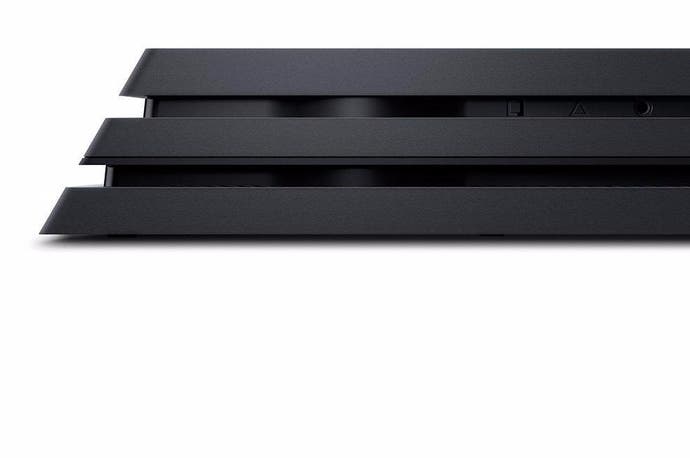PS4 Pro boost mode: a game-changer for unpatched titles?
UPDATED: Can boost mode fix Just Cause 3's most severe frame-rate problems?
UPDATE 14/2/17 3:30pm: Rounding off our analysis of PS4 Pro's upcoming boost mode, we take a look at a title that clearly requires as much horsepower as possible - Avalanche's Just Cause 3. It's been six months since we last looked at the game in the wake of reports that a succession of patches had actually made in-game performance worse, not better. Our results back then were inconclusive, but one thing was clear - with lows of 15fps, the title clearly needed substantial optimisation work.
The bad news is that returning to Just Cause 3 this month, nothing has really improved on base hardware - frame-rate is still visibly impacted by advanced physics work, large explosions and even traversing the open world (where we assume the CPU is tested as it streams in and decompresses open world data). The good news is that boost mode does help to a certain extent. Open world streaming slowdown is visibly improved while physics work can also see tangible improvements. However, as the video clearly demonstrates, even with boost mode active, Just Cause 3 still has severe issues in maintaining its target 30fps.
At this point, hopes are fading for the optimisation push this title really needs. Boost mode will provide an improved experience, but at this point, there's little alternative other than to run the title on PC if you're looking for the best way to play this game.
UPDATE 11/2/17 2:20pm: Based on community feedback, we've gone back and tested more titles under PS4 Pro's upcoming boost mode, coming soon to system software 4.5 - currently in beta. We've covered fan-favourite titles including The Witcher 3, Bloodborne, Dark Souls 3 and Batman: Arkham Knight. Out of the titles mentioned, it's Rocksteady's final Dark Knight outing that shows the most improvement, while for Souls fans, it's actually the Scholar of the First Sin remaster that benefits most, clocking in at the rock-solid 60fps we really wanted from the original release.
But that's not the end of our testing. We've also dipped into Oddworld: New 'n' Tasty along with horror classic, Until Dawn, based on Guerrilla Games' Decima engine. However, if it's impressive improvements to base performance you're looking for, check out Lords of the Fallen and The Evil Within (running in full-screen mode, of course). We're in the process of rounding off our tests at the moment, with Just Cause 3 still in the pipeline - and we'll also be comparing Fallout 4's brand-new 1.14 Pro patch with the older 1.12 code running under boost mode. Let's just say that initial results are fascinating - more on that very soon...
Original story:It's the PlayStation 4 Pro feature we've been waiting for. The new boost mode - coming soon in the 4.5 system software upgrade - opens up the power of the Pro to unpatched base PS4 titles. It's available to beta users to test now and we've spent the last few days putting the feature through its paces. The improvements vary from the dramatic to the inconsequential, but by and large, the end result is a highly valuable feature that we think Pro owners are going to love.
Going into the tests, we were cautiously optimistic. There are improvements we should expect from boost mode, but equally, we need to be aware of its limitations. Developers define the performance targets of console software, and set the ceiling for in-game frame-rates almost always in the form of a 30fps or 60fps cap. Some titles - for example, Killzone Shadow Fall - can run with an unlocked frame-rate, but v-sync still dictates an eventual 60fps cap.
In short, boost mode will work best in stabilising performance closer to target frame-rates and should prove interesting on unlocked titles, but you can't expect game-changing miracles. Games like Destiny that stick doggedly to their 30fps cap will see no improvement, and titles certainly won't break their performance limits and suddenly run at 60fps. However, there are plenty of games out there that glitch badly or run nowhere near their theoretical limits. In this scenario, boost mode could be revelatory.
Our first order of business was to figure out what boost mode actually does. The test here was pretty straightforward - we ran performance analysis for Knack, a game that runs with an unlocked frame-rate and also happens to have a Pro patch. We benched the game running on the Pro without its patch in base and boost modes, and stacked it up against patched performance. Knack's official Pro upgrade includes a mode that brings standard 1080p gameplay much closer to 60fps, so this should reveal just how much of the Pro's ultimate performance boost mode has access to. Here, results show only a 14 per cent boost to graphics throughput - nowhere near the full power of the Pro as seen in the official patch. Killzone Shadow Fall again delivers a similar 14 per cent performance uplift - a useful boost, but not a revelation.
| Base PS4 | PS4 Pro | Boost | |
|---|---|---|---|
| CPU | Eight Jaguar cores clocked at 1.6GHz | Eight Jaguar cores clocked at 2.1GHz | 1.3x |
| GPU | 18 Radeon GCN compute units at 800MHz | 36 improved GCN compute units at 911MHz | 2.3x FLOPs |
| Memory | 8GB GDDR5 at 176GB/s | 8GB GDDR5 at 218GB/s | 24% more bandwidth, 512MB more useable memory |
However, there are big, big bumps to performance in other titles. Ubisoft's Assassin's Creed Unity on PS4 is notorious for its sub-par performance, with even an extensive optimisation push only resulting in 22-24fps frame-rates in NPC-heavy areas. The upgrade on Pro is hugely impressive. The title hits 30fps for the vast majority of the duration with only slight dips beneath the target. A hugely ambitious console title that lacked the horsepower to deliver a decent experience is finally running as it should - and it's really worth revisiting with Pro's boost mode active.
Battlefield 4's performance-sapping 64-player online battles also see a vast improvement - we dipped into an intense multiplayer session and saw a marked improvement, representing a vast increase in fluidity over the same map running on the base PS4 hardware. The Frostbite engine also sees improvement in Mirror's Edge Catalyst - a game that targets 60fps but is beset by unfortunately dips in performance throughout. All of these are addressed by boost mode.
Racing titles that target 60fps also see tangible improvements. Project Cars lets users record replays that provide completely like-for-like gameplay clips for our testing. In the most demanding stress tests, we found a huge frame-rate uplift in the region of 35 to 38 per cent. Assetto Corsa? It's a title besieged by wobbly performance on base PS4 hardware, but boost mode locks this game to 60fps. F1 2016 doesn't quite see the same level of improvement, with improvements in the 7-8fps area, but everything counts in a precision racer targeting 60Hz gameplay.
There are many more tests contained in John Linneman's extensive video analysis above, but the bottom line is that the Pro's boost mode is delivering a diverse range of performance increases, so again, the question must be asked: what does this new addition to the PlayStation 4 Pro's capabilities actually deliver on a technical level?
The working theory we have is pretty straightforward. In graphics-limited tests, boost mode consistently delivers a 14 per cent increase in frame-rate and we suspect that it is not coincidence that the GPU clock speed bump from base to Pro hardware is 111MHz - pretty much exactly 14 per cent. The suggestion is that when running base mode with boost active, the Pro 'half' of the larger GPU remains inactive, but additional clocks are deployed instead.
Meanwhile, the CPU appears to enjoy the full benefit of the additional power the Pro provides. The Assassin's Creed Unity tests we carried out show an almost linear scaling in performance - 23fps gameplay on base scales to 30fps in boost mode, exactly in line with the additional 31 per cent of CPU power the Pro is capable of delivering. Drops to 22fps on base see boost mode hit 29fps - we've hit the limit there in terms of the improvement offered by the increased CPU clocks. Project Cars' impressive 35-38 per cent increase? Perhaps this is a combination of all of the boost mode's CPU and GPU upgrades.
Sony has also talked about decreased loading times via boost mode - an aspect of the Pro we've been looking at in-depth recently. We have noticed in our PC CPU testing that there's a big increase in loading times when using a dual-core processor up against a quad. It may well be the case that streaming in and decompressing assets is faster on Pro not because of its SATA-3 interface, but because the big bump to CPU power means that compressed assets are unpacked more quickly.
What's most fascinating about PS4 Pro's new boost mode is that by disproportionately increasing CPU power vs GPU, we actually seem to be ending up with an improved hardware balance for base mode. For example, we know that many Unreal Engine 3 ports to PS4 have suffered owing to the lack of CPU power available. Boost mode addresses this comprehensively: the flawed BioShock Infinite port performs much more consistently, while Mighty No 9 also sees a vast improvement in performance. However, time and time again, graphics-bound scenarios continually hand in 14 per cent improvements - it's enough to get Tomb Raider Definitive Edition to more consistently deliver 60fps, but not enough for a locked 1080p60 experience.
So maybe boost mode does indeed deliver all the CPU and possibly the memory bandwidth improvements inherent in the PS4 Pro hardware design, but the more modest boost to GPU power is curious - it seems that boost mode accesses the extra frequency but not the Pro's 18 additional compute units. We went to Sony with our theory, and while technical details in its reply are sparse, here's the statement we received back.
"Boost Mode has been designed to provide better performance for those legacy titles that have not been patched to take advantage of the PS4 Pro's faster CPU and its faster and double-sized GPU," Sony says. "This can provide a noticeable frame-rate boost to some games with variable frame-rate, and can provide frame-rate stability for games that are programmed to run at 30Hz or 60Hz.
"Depending on the game, the increased CPU speed may also result in shorter load times. Boost Mode is not guaranteed to work with all titles, however, turning the setting off will allow the game to be played in a mode that replicates the standard PS4. As an aside, the older unpatched titles that run in Boost Mode are unaware that they are running on a PS4 Pro and consequently don't take full advantage of the PS4 Pro capabilities; power consumption for these games will therefore be a bit lower compared to playing a newer title."
We'll be spending a little more time with boost mode - or beast mode, as it's colloquially known as - and plan to look into specific titles where we should see big improvements, based on the results we've uncovered so far. The Witcher 3, Just Cause 3, the Souls titles and Bloodborne are all on the list. Do let us know if there are any other specific titles that deserve a full breakdown, and we'll update soon with more testing.























